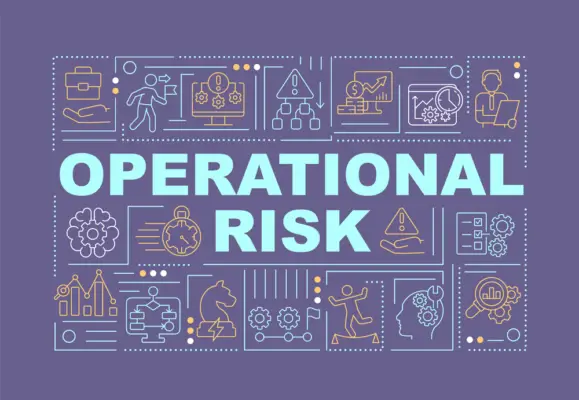Key Risk Indicators (KRIs) for operational risk can vary widely depending on an organisation’s specific operations and industry.
Some examples of operational risk KRIs include the number of accounting deadlines missed, which can indicate process inefficiencies or poor internal controls, as mentioned in a blog post by SolveXia.
Another example is the employee turnover rate, which can reflect the health of an organization’s culture and operational stability, as highlighted by Secureframe.
Operational risk is defined as the risk of loss resulting from inadequate or failed internal processes, people and systems, or external events, as detailed by Workiva.
In operational risk management, identifying key indicators is crucial for proactively mitigating potential threats to an organization’s operations. Examples of such indicators span across various facets of the business, including:
- Financial performance metrics that can signal underlying vulnerabilities.
- Compliance and regulatory violations may expose the company to legal repercussions.
- The intricate web of vendor and third-party risks could impact the supply chain.
Tracking incident and loss data also provides valuable insights into areas requiring heightened attention. Understanding these key risk indicators is not just a matter of foresight but a strategic necessity for safeguarding organizational resilience.

Key Takeaways
- Monitoring operational risk through key risk indicators is essential for effective risk management.
- Types of operational risks include strategic, compliance, technological, and reputational risks.
- Compliance and regulatory risks play a crucial role in evaluating operational risk.
- Managing vendor and third-party risks requires strong internal controls and thorough due diligence.
Financial Performance Metrics
Financial performance metrics are crucial in assessing an organisation’s financial health and stability. These metrics provide insights into profitability, liquidity, and overall financial strength.
Definition of key risk indicators (KRIs)
When assessing operational risk, key indicators (KRIs) are essential in monitoring and evaluating potential vulnerabilities within a business’s financial performance metrics.
| Key Risk Indicators (KRIs) | Definition |
|---|---|
| Financial Leverage | Measures a company’s debt levels relative to its equity. |
| Liquidity Ratio | Evaluates a firm’s ability to meet short-term obligations. |
| Profit Margin | Indicates a company’s profitability from its revenue. |
Importance of KRIs in identifying and managing operational risks
Utilizing key risk indicators (KRIs) is imperative for effectively identifying and managing operational risks within an organization’s financial performance metrics.
- Enhanced Risk Management: KRIs provide a comprehensive approach to assessing operational risk exposure.
- Timely Identification: They aid in promptly identifying potential risks through specific risk metrics.
- Proactive Risk Management: KRIs enable proactive management of operational risks.
- Ongoing Risk Monitoring: Facilitates continuous monitoring of risks for timely interventions.
Understanding Operational Risk
Given the critical role of key risk indicators (KRIs) in enhancing risk management practices, gaining a deeper understanding of operational risk within an organization’s financial performance metrics is essential.
Operational risk management involves identifying various types of risks, potential risk scenarios, and the impact of risk events on business operations.
The management team must assess risk exposure, allocate operational risk capital, and conduct comprehensive risk assessments for effective mitigation.
| Types of Risks | Risk Identification Methods | Impact on Business Operations |
|---|---|---|
| Operational Risks | Risk Scenarios | Disruption |
Definition of operational risk
Incorporating operational risk into financial performance metrics provides a comprehensive framework for assessing the impact of potential risks on an organization’s operational and financial stability.
- Identifying key risk indicators (KRIs) to monitor operational risk exposure.
- Setting thresholds for warning signs of heightened risk.
- Implementing strategies to mitigate potential losses.
- Enhancing overall risk management practices to address business risks effectively.
Types of operational risks
Operational risks within the realm of financial performance metrics encompass a spectrum of potential threats that can adversely impact an organization’s operational and financial stability.
Types of operational risks include strategic, compliance, technological, and reputational risks.
Operational risk exposure necessitates robust operational risk management strategies involving thorough operational risk assessment, effective operational risk mitigation techniques, and continuous operational risk monitoring to safeguard the organization’s financial performance metrics.
Compliance and Regulatory Violations
In evaluating operational risk, a critical aspect to consider is compliance and regulatory violations. Understanding and monitoring key risk indicators in this area can provide valuable insights into the organization’s adherence to laws and regulations.
Key Risk Indicators Examples for Operational Risk
Examples of key risk indicators for operational risk related to compliance and regulatory violations help organizations monitor and mitigate potential threats effectively.
- Number of Compliance Violations: Tracking the frequency of regulatory breaches.
- Percentage of Regulatory Requirements Met: Assessing adherence to compliance standards.
- Cyber Risk Exposure Index: Monitoring vulnerabilities in technology infrastructure.
- Effectiveness of Risk Mitigation Plans: Evaluating the success of risk management strategies.
Customer Satisfaction
Ensuring high levels of customer satisfaction is paramount for organizations in maintaining compliance and minimizing regulatory violations. Monitoring customer satisfaction through key performance indicators is crucial in identifying potential risks.
Risk assessments should include customer complaints as key risk indicators examples.
Implementing effective risk management strategies aligned with strategic objectives and business objectives can help mitigate potential customer dissatisfaction and regulatory non-compliance threats.
Importance of customer satisfaction as a KRI
Monitoring customer satisfaction levels is a critical Key Risk Indicator (KRI) in safeguarding against organisations’ compliance breaches and regulatory violations.
- Early Warning System: Customer satisfaction trends can signal potential issues with internal processes.
- Enhanced Reputation: Satisfied customers reduce the impact of corporate risks.
- Improved Risk Management: Focusing on customer satisfaction enhances overall risk management processes.
- Regulatory Compliance: High satisfaction levels often indicate adherence to compliance standards.
Business Continuity Planning
Business Continuity Planning is crucial for organizations to ensure uninterrupted operations during unforeseen events.
Monitoring customer feedback and complaints allows businesses to address potential issues before they escalate.
Security breach incidents can significantly impact operations, emphasizing the need for robust contingency plans.
Monitoring customer feedback and complaints
Promptly addressing and analyzing customer feedback and complaints is critical to effective Business Continuity Planning.
- Establish clear metrics for monitoring customer feedback and complaints.
- Define escalation levels for different types of feedback or complaints.
- Utilize key risk indicators to track risk exposure related to customer satisfaction.
- Integrate customer feedback analysis into overall risk management strategies.
Security Breach Incidents
The detection and response to security breach incidents are paramount in ensuring the resilience and continuity of business operations.
| Security Breach | Incidents |
|---|---|
| Cybersecurity Risk | Ransomware Attack |
| Network Attack | Risk of Loss Resulting from Breach |
Impact of security breaches on operations
Following a breach incident, the operational impact on an organization becomes a critical focus, particularly in the context of Business Continuity Planning.
- Disruption in regular operations.
- Financial losses due to downtime.
- Damage to reputation and customer trust.
- Increased risk exposure to future cyber attacks.
Vendor and Third-Party Risks
Vendor and third-party risks pose significant challenges to organizations, especially in terms of monitoring cybersecurity measures and incidents.
The effectiveness of the control environment becomes crucial when dealing with external entities that may introduce vulnerabilities.
Strong internal controls are key in mitigating operational risks arising from dependencies on vendors and third parties.
Monitoring cybersecurity measures and incidents
Organizations can proactively manage risks associated with third-party relationships by analysing cybersecurity measures and incidents.
- Implement regular cybersecurity audits to assess vulnerabilities.
- Monitor network traffic for unusual activities that may indicate a breach.
- Utilize intrusion detection systems to identify and respond to cyber threats promptly.
- Conduct thorough due diligence when onboarding new vendors to ensure their cybersecurity measures align with organizational standards.
Control Environment Effectiveness
Analyzing the control environment effectiveness is crucial in mitigating vendor and third-party risks within an organization’s operational framework.
Effective control environments help identify key risks associated with vendors and third parties, allowing for a proactive risk management approach.
Risk managers play a significant role in assessing the risk posture related to vendor relationships and categorizing them under strategic risk within the enterprise risk management program.

| Risk Category | Role in Risk Management |
|---|---|
| Vendor Risks | Identify key risks |
| Third-Party Risks | Proactive assessment |
| Strategic Risk | Categorization |
| Enterprise Program | Managing relationships |
Importance of strong internal controls in mitigating operational risks
How can organizations effectively mitigate operational risks related to vendors and third parties by implementing robust internal controls?
Strong internal controls are crucial in managing risk exposure in the vendor and third-party landscape. To achieve this, organizations can:
- Conduct regular audits of vendor relationships.
- Implement vendor risk assessment frameworks.
- Monitor third-party performance closely.
- Establish clear contractual obligations and SLAs.
Incident and Loss Data Tracking
Organizations must track incident and loss data to manage operational risk to assess control effectiveness effectively.
Monitoring through audits and assessments is crucial in identifying weaknesses and implementing necessary improvements.
Monitoring control effectiveness through audits and assessments
Monitoring control effectiveness through audits and assessments, particularly through Incident and Loss Data Tracking, is crucial for managing operational risk.
- Regular performance evaluations ensure control effectiveness.
- Audits help identify gaps in the control framework.
- Continuous monitoring enhances risk mitigation strategies.
- Assessments streamline the selection process for key risk indicators.
Frequently Asked Questions
How Can Organizations Effectively Prioritize Key Risk Indicators in Operational Risk Management?
To effectively prioritize key risk indicators in operational risk management, organizations must first conduct a thorough risk assessment to identify potential threats.
Prioritization should be based on the likelihood and impact of each risk on business objectives.
What Are Some Common Challenges Organizations Face When Implementing Key Risk Indicators for Operational Risk?
When implementing key risk indicators for operational risk, organizations often face challenges in defining relevant metrics, ensuring data accuracy, aligning with strategic objectives, fostering a risk-aware culture, and effectively integrating KRI monitoring into daily operations.
How Do Organizations Ensure the Accuracy and Reliability of Data Used to Track Key Risk Indicators in Operational Risk?
Organizations ensure data accuracy and reliability for tracking risk indicators by implementing robust data collection processes, establishing data quality standards, conducting regular audits, utilizing advanced technology for data validation, and fostering a culture of accountability within the organization.
What Are Some Best Practices for Leveraging Key Risk Indicators to Mitigate Operational Risks Proactively?
To proactively mitigate operational risks, organizations can establish a robust framework for identifying, monitoring, and responding to key risk indicators.
This involves continuous assessment, timely escalation protocols, cross-functional collaboration, and a culture of risk awareness.
How Do Organizations Measure the Effectiveness of Their Key Risk Indicators in Identifying and Assessing Operational Risks?
Organizations measure the effectiveness of key risk indicators in identifying and assessing operational risks through data analysis, trend monitoring, and correlation with actual risk events.
Regular reviews, feedback loops, and adjustments ensure KRI relevance and accuracy.

Conclusion
To sum up, it is possible to monitor operational risks in an effective way by using key risk indicators, such as…:
- Financial performance metrics.
- Compliance and regulatory violations.
- Business continuity planning.
- Vendor and third-party risks.
- Incident and loss data tracking.
These indicators provide valuable insights into potential threats to an organization’s operational stability and help implement proactive risk management strategies to mitigate these risks.
Organizations can improve their risk management by monitoring key indicators.

Chris Ekai is a Risk Management expert with over 10 years of experience in the field. He has a Master’s(MSc) degree in Risk Management from University of Portsmouth and is a CPA and Finance professional. He currently works as a Content Manager at Risk Publishing, writing about Enterprise Risk Management, Business Continuity Management and Project Management.

